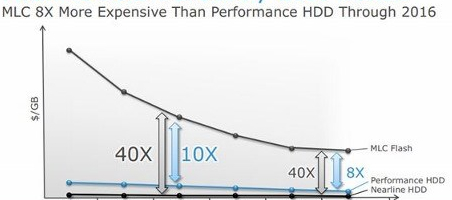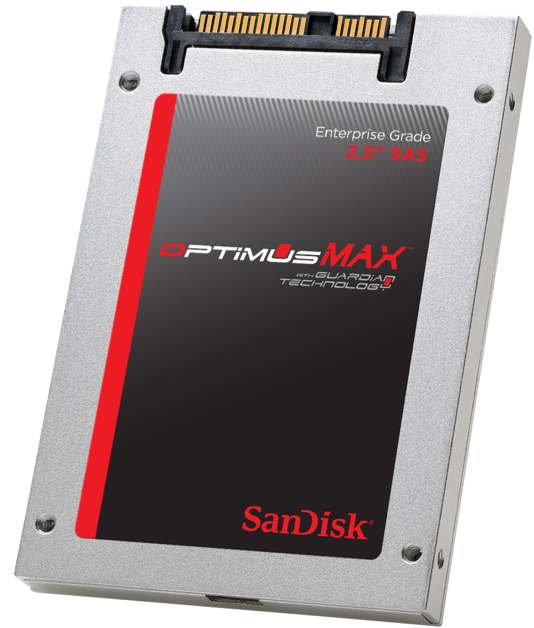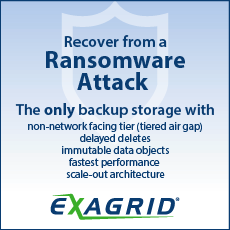SanDisk SSD at 4TB
Worldwide record of capacity for 2.5-inch SAS SSD
This is a Press Release edited by StorageNewsletter.com on May 5, 2014 at 3:19 pmSanDisk Corporation announced the Optimus MAX SAS SSD, the industry’s first 4TB SAS SSD.
The Optimus MAX SSD achieves a capacity point that outpaces today’s highest-capacity 2.5″ 10K and 15Krpm SAS HDDs, making a replacement for legacy mission-critical data center SAS HDDs.
It delivers SAS performance and functionality at a price point that was previously only available in SATA-based SSDs. It tops the newly refreshed Optimus SAS SSD family and also joins the company’s newly announced Lightning Gen. II 12Gb SAS SSDs, extending SanDisk’s entire SAS portfolio to cover the performance, capacity and endurance needs of an array of enterprise applications.
“Customers have been looking for a way to transition their data centers from HDDs to NAND flash, but have been forced to decide between cost and performance, or give up important functionality,” said John Scaramuzzo, SVP and GM, enterprise storage solutions, SanDisk. “The Optimus MAX eliminates the need for compromises. We believe that the Optimus MAX will be a disruptive force within the storage industry, catalyzing many organizations to make the switch from their HDD-prominent data center infrastructures to SSDs.”
Historically companies have relied on 10K and 15Krpm SAS HDDs for mission-critical applications because they provided relatively high performance at a low cost. However, as data volumes increase and real-time access to information becomes more critical, companies are finding that traditional HDDs can’t meet application demands. The Optimus MAX SSD offers an alternative-delivering cost effective, high-density storage with SSD-class performance, allowing enterprises to replace under-performing HDDs while leveraging their current SAS storage infrastructures. With the Optimus MAX SSD, customers experience cost savings in infrastructure expenses (i.e., fewer racks, power supplies, HBAs, etc.), resulting in a lower capital acquisition cost, lower power and footprint requirements, and greater cost reductions that are realized in TCO.
“Currently, SSDs are used to accentuate high-capacity HDDs in traditional enterprise, cloud and hyperscale data centers, however, increasing numbers of IT managers are finding that they need accelerated performance,” said Laura DuBois, program VP for IDC’s storage practice. “As SSDs, such as SanDisk’s new Optimus MAX, continue to increase in capacity while achieving greater cost-effectiveness, more enterprises will look to SSDs to replace their legacy HDD infrastructures in order to meet today’s high I/O applications and enterprise workload requirements.“
As with all Optimus drives, the Optimus MAX SSD includes the company’s proprietary Guardian Technology Platform, comprised of FlashGuard, DataGuard and EverGuard technologies that work in concert to provide a combination of error correction and detection technology, data path protection, and data fail recovery from lower cost MLC flash. The Optimus MAX SSD also offers customers the performance, uptime and longevity suitable for read-intensive enterprise workloads.
Tracking to each drives’ endurance capabilities,
the new Optimus SSD product family includes:
- Optimus MAX SSD (1-3 full DWPD)
- Optimus Eco SSDs (1-3 full DWPD)
- Optimus Ascend SSDs (10 full DWPD)
- Optimus Ultra SSDs (25 full DWPD), and
- Optimus Extreme SSDs (45 full DWPD)
With this update, the Optimus SSD product family delivers a single SAS platform that can address a range of enterprise application performance, capacity and endurance requirements.
The Optimus MAX SSD and renewed Optimus family of drives will be available with TCG Enterprise Security Subsystem Class compliance to select OEMs and through the channel in Q3 2014.
Comments
We keep a database of all SSDs, with their main specs, released since 1995 and probably the firts one, the DiskonChip from M-Systems, total representing 811 units up to now from 123 manufacturers as of today.
With this announcement SanDisk stated that the Optimus MAX is the "first 4TB enterprise SAS SSD." Exact.
It's also true that it "outpaces today's highest-capacity 2.5-inch 10,000 and 15,000rpm SAS HDDs", the record being 1.2TB for these kind of HDDs by Seagate on its 6Gb SAS Enterprise Performance 10K.7 revealed last year. And SanDisk hopes to reach 6TB and 8TB into Optimus MAX SSDs next year, according to US source.
But in 3.5-inch form factor, the latest Seagate Enterprise Capacity v4 and HGST Ultrastar HE6 HDDs culminate at 6TB with SATA and SAS interfaces.
Flash vs. HDD: Industry Cost Trends
(Source, EMC)
You can reach more than that 4TB with PCIe SSDs because they have higher volume to store flash chips than standard 2.5-inch form factor.
Other SSD milestones in term of capacity are:
- For PCIe: worldwide record of 16TB for the OCZ Technology Z-Drive R4 CloudServ RM1616 released in 2012 but being a special unit featuring 16 SandForce SF-2582 controller on a single, double slot, PCIe card, interface remaining PCIe x8 although the connector being physically a x16 interface; and note also 14TB in RAID mode on the Virident Systems (now WD/HGST) FlashMAX MLC announced in 2011 at $13,000!
- In 2.5-inch form factor with SATA interface: 2TB by Avant Technology (2000), Foremay (models SC199 and TC166 in 2000), OCZ Technology - now Toshiba - (Indilinx Everest 2, 2012).
- In 3.5-inch form factor: 4TB by OCZ (Chiron, 2012).
SSDs at 2TB and more
| Year of release | Manufacturer | Model | Form factor/ interface | Capacity in MB |
| 2014 | ADATA | NA | PCIe | 2000 |
| 2013 | Avant Technology | NA | 2.5, 6Gb SATA | 2000 |
| 2012 | BiTMICRO | maxIO | PCIe FH | 4500 |
| 2014 | CoreRise | Comay BladeDrive E28 | PCIe 2.0 | 3200 |
| 2009 | Dolphin ICS | StorExpress | PCIe | 4000 |
| 2013 | Dulce Systems | Pro SSD | PCIe 3 | 2000 |
| 2009 | Foremay | EC188 D-Series | PCIe | 2000 |
| 2010 | Foremay | EC188 D-Series | PCIe | 4000 |
| 2010 | Foremay | EC188 D-Series | PCIe | 8000 |
| 2011 | Foremay | EC188 D-series | PCIe | 12000 |
| 2013 | Foremay | SC199 | 2.5 | 2000 |
| 2013 | Foremay | TC166 | 2.5 | 2000 |
| 2011 | Fusion-io | ioDrive Duo | PCIe | 2400 |
| 2013 | Fusion-io | ioScale | PCIe | 3200 |
| 2013 | LSI | WarpDrive BFH8-3200 | PCIe 3.0 | 3200 |
| 2013 | LSI | Nytro XP6210-4A2048 | PCIe 2.0 | 2000 |
| 2010 | OCZ Technology | Z-Drive R2 p88 | PCIe | 2000 |
| 2012 | OCZ Technology | Indilinx Everest 2 | 2.5, 6Gb SATA | 2000 |
| 2012 | OCZ Technology | Z-Drive R4 CloudServ RM1616 | PCIe | 16000 |
| 2012 | OCZ Technology | Chiron 4TB SSD | 3.5 | 4000 |
| 2013 | OCZ Technology | Z-Drive R4 | PCIe | 3200 |
| 2014 | OCZ/Toshiba | Z-Drive 4500 | PCIe | 3200 |
| 2013 | OWC | Mercury Viper | 3.5, 6Gb SATA | 2000 |
| 2014 | SanDisk | Optimus MAX | 2.5, 6Gb SAS | 4000 |
| 2013 | Seagate | X8 Accelerator | PCIe | 2222 |
| 2009 | Super Talent | RAIDDrive GS | PCIe | 2000 |
| 2014 | Super Talent | RAIDDrive II Plus | PCIe | 2000 |
| 2011 | Virident Systems | FlashMAX MLC | PCIe | 14000 |
| 2012 | Virident Systems | FlashMAX II PCIe | PCIe | 2200 |
| 2013 | Virident Systems | FlashMAX II Capacity | PCIe low profile | 4800 |














 Subscribe to our free daily newsletter
Subscribe to our free daily newsletter

